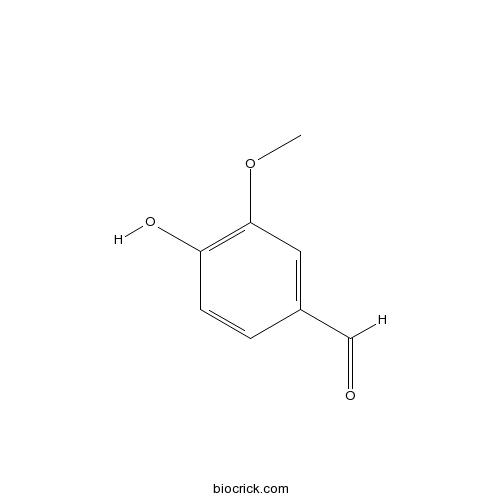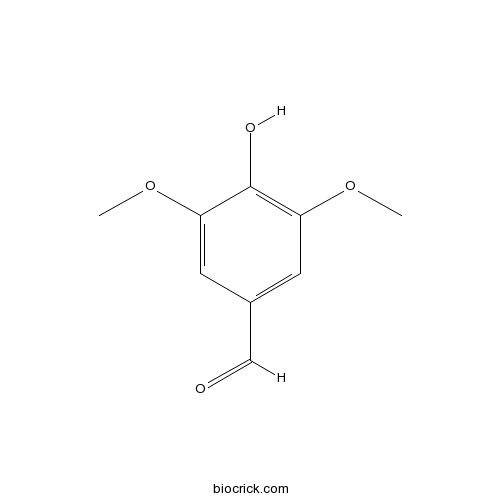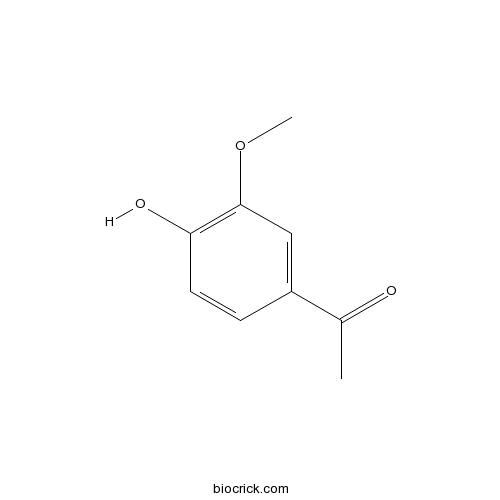Gypsophila oldhamiana
Gypsophila oldhamiana
1. The products in our compound library are selected from thousands of unique natural products; 2. It has the characteristics of diverse structure, diverse sources and wide coverage of activities; 3. Provide information on the activity of products from major journals, patents and research reports around the world, providing theoretical direction and research basis for further research and screening; 4. Free combination according to the type, source, target and disease of natural product; 5. The compound powder is placed in a covered tube and then discharged into a 10 x 10 cryostat; 6. Transport in ice pack or dry ice pack. Please store it at -20 °C as soon as possible after receiving the product, and use it as soon as possible after opening.
Natural products/compounds from Gypsophila oldhamiana
- Cat.No. Product Name CAS Number COA
-
BCN2605
Vanillin121-33-5
Instructions

-
BCN6186
4-Hydroxy-3,5-dimethoxybenzaldehyde134-96-3
Instructions

-
BCN6307
Arbutin497-76-7
Instructions

-
BCN2916
Acetovanillone498-02-2
Instructions

Two new triterpenoids from Gypsophila oldhamiana.[Pubmed: 26539898]
Two new triterpenoids (1-2) were isolated and elucidated from the roots of Gypsophila oldhamiana, together with four known triterpenoids (3-6). Their structures were identified to be 3β-hydroxyolean-13(18)-ene-23, 28-dioic acid (1), 3β, 12α-dihydroxy-23-carboxyolean-28, 13β-olide (2), 3β, 16α-dihydroxy-23-oxoolean-13(18)-en-28-oic acid (3), gypsogenin (4), quillaic acid (5) and gypsogenic acid (6) by spectral methods. All compounds were tested for their cytotoxicities against human tumour cell lines (lung cancer H460 and gastric cancer SGC-7901) and for their antiangiogenic effects using a zebra fish model. All compounds showed interesting antiangiogenic activities and the significant cytotoxicities against H460.
Two new β-carboline alkaloids from the roots of Gypsophila oldhamiana.[Pubmed: 25554101]
Phytochemical investigation of the roots of Gypsophila oldhamiana afforded two new β-carboline alkaloids, oldhamiaines A and B (1 and 2), along with a known analogue (3). Their structures were elucidated by using spectroscopic and chemical methods. This is the first report of β-carboline alkaloids in the genus Gypsophila.
Oldhamianoside II, a new triterpenoid saponin, prevents tumor growth via inducing cell apoptosis and inhibiting angiogenesis.[Pubmed: 23924857]
Oldhamianoside II is a new triterpenoid saponin that was isolated from the roots of Gypsophila oldhamiana. The present study aims to investigate the potential inhibitory activity of oldhamianoside II on tumor growth using an S180 tumor implantation mouse model. Oldhamianoside II at doses of 5.0 and 10.0 mg/kg was given with intraperitoneal injection for 10 days following subcutaneous inoculation of S180 tumor cells in anterior flank of mice. The tumor growth, the cell apoptosis, the microvessel density (MVD) in S180 tumors, the tumor cell viability, the tubular formation in vitro, and migration of tumor cells were examined. The expression of vascular endothelial growth factor (VEGF), basic fibroblast growth factor (bFGF), and cyclooxygenase-2 (COX-2) was determined to analyze the associated mechanisms. The results showed that oldhamianoside II potently inhibited tumor cell viability in vitro. In addition, oldhamianoside II delayed tumor growth in anterior flank, induced S180 cell apoptosis, and reduced the MVD. Oldhamianoside II was also demonstrated to decrease the number of tubular structure and vessel formation in HUVEC cultures and chick embryo chorioallantoic membrane (CAM) model, respectively. Further study indicated that oldhamianoside II reduced the expression of VEGF, bFGF, and COX-2 in tumor sections. Moreover, oldhamianoside II inhibited the activity of migration and penetration to Matrigel of SGC7901 tumor cells in scratch wound and transwell chamber. In conclusion, our work defines oldhamianoside II, a new triterpenoid saponin, as a novel compound that can effectively inhibit S180 tumor growth, induce tumor cell apoptosis, prevent tumor angiogenesis, and inhibit cancer cell migration, suggesting that oldhamianoside II is a potential drug candidate for the treatment of cancer and for the prevention of metastasis.
Different apoptotic effects of triterpenoid saponin-rich Gypsophila oldhamiana root extract on human hepatoma SMMC-7721 and normal human hepatic L02 cells.[Pubmed: 23811557]
The roots of Gypsophila oldhamiana are rich in triterpenoid saponins with antitumor properties. Although previous reports have revealed the anticancer potency of some Gypsophila species, the underlying molecular mechanisms of this activity have not been studied in detail. The purpose of the present study was to prepare a triterpenoid saponin-rich G. oldhamiana root extract (TGOE) determined by LC-electrospray ionization (ESI)-MS(n) for biological studies and to evaluate the different anti-proliferative activities and apoptotic effects of TGOE on human hepatoma SMMC-7721 and normal human hepatic L02 cells. 3-(4,5-Dimethylthiazol-2-yl)-2,5-diphenyltetrazolium bromide (MTT) assay showed that TGOE selectively inhibited the proliferation of SMMC-7721 cells in a dose-dependent manner with IC50 value of 19.50±3.63 µg/mL, while the cytotoxic effects of TGOE on L02 cells were much lower with IC50 value of 40.48±3.74 µg/mL. Analysis of apoptotic morphological changes and flow cytometry indicated that TGOE might preferentially induce apoptosis in SMMC-7721 cells, while exhibited much lower effects on L02 cells. Western blot analysis showed that the different apoptotic effects of TGOE on SMMC-7721 and L02 cells were due to different protein regulation of caspase-3 and mitogen activated protein kinases (MAPKs). TGOE significantly activated caspase-3 and increased the phosphorylation of extracellular signal-regulated kinase (ERK) and c-Jun N-terminal kinase (JNK), while decreased the phosphorylation of p38 in SMMC-7721 cells. However, the expression of these proteins was not statistically changed in L02 cells, except for the up-regulation of p38 phosphorylation. These results suggest that TGOE may have potential beneficial effects against hepatocellular carcinoma.
Six new cyclic peptides from the roots of Gypsophila oldhamiana.[Pubmed: 23546010]
Six new cyclic peptides, gypsophin A-F (1-6), were isolated from Gypsophila oldhamiana. Their structures were elucidated by extensive NMR and chemical degradation. Compound 3 exhibited moderate activity of antiplatelet aggregation in vitro.
New pentacyclic triterpenes from Gypsophila oldhamiana and their biological evaluation as glycogen phosphorylase inhibitors.[Pubmed: 18493961]
The three new pentacyclic triterpenes 1-3 were isolated and elucidated from the roots of Gypsophila oldhamiana, together with seven known triterpenes (4-10). These triterpenes were evaluated for their glycogen phosphorylase inhibitory activity and preliminary structure-activity trends are suggested.
New triterpenoid saponins with strong alpha-glucosidase inhibitory activity from the roots of Gypsophila oldhamiana.[Pubmed: 18194870]
Seven new triterpenoid saponins (1-7), have been isolated and elucidated from the roots of Gypsophila oldhamiana together with five known triterpenoid saponins (8-12). These saponins which could be classified into three series: 3-O-monoglucosides (1, 8, 9), 28-O-monoglucosides (2-4, 12) and 3, 28-O-bidesmosides (5-7, 10, 11), have been evaluated for their alpha-glucosidase inhibition activity. As a result, the preliminary structure-activity relationships were discussed based on the position of sugar linkage attached to the aglycone, and 28-O-monoglucosides 2-4 and 12 showed significant inhibitory activities on alpha-glucosidase.
Gypsophin: a novel alpha-glucosidase inhibitory cyclic peptide from the roots of Gypsophila oldhamiana.[Pubmed: 17587576]
An unusual new cyclic peptide with a pyrrolidine-2,5-dione unit, gypsophin (1), was isolated from Gypsophila oldhamiana. Its structure was elucidated by the spectroscopic evidences. The stereochemistry was determined by application of the Marfey's method and the single-crystal X-ray diffraction. Compound 1 exhibited inhibitory activity against alpha-glucosidase with IC50 of 305 microM.
A major triterpenoid saponin from Gypsophila oldhamiana.[Pubmed: 17511010]
A new saponin, gypoldoside A (1), was isolated from the roots of Gypsophila oldhamiana. On the basis of in-depth NMR-spectroscopic and mass-spectrometric analysis, in combination with chemical evidence, its structure was established as 3-O-{beta-D-galactopyranosyl-(1-->2)-[beta-D-xylopyranosyl-(1-->3)]-beta-D-glucuronopyranosyl}quillaic acid 28-[alpha-L-arabinopyranosyl-(1-->2)-alpha-L-arabinopyranosyl-(1-->3)-beta-D-xylopyranosyl-(1-->4)-alpha-L-rhamnopyranosyl-(1-->2)-beta-D-fucopyranosyl] ester. Compound 1 was found to be highly active against three different human cancer cell lines, with IC50 values in the low micromolar range.


